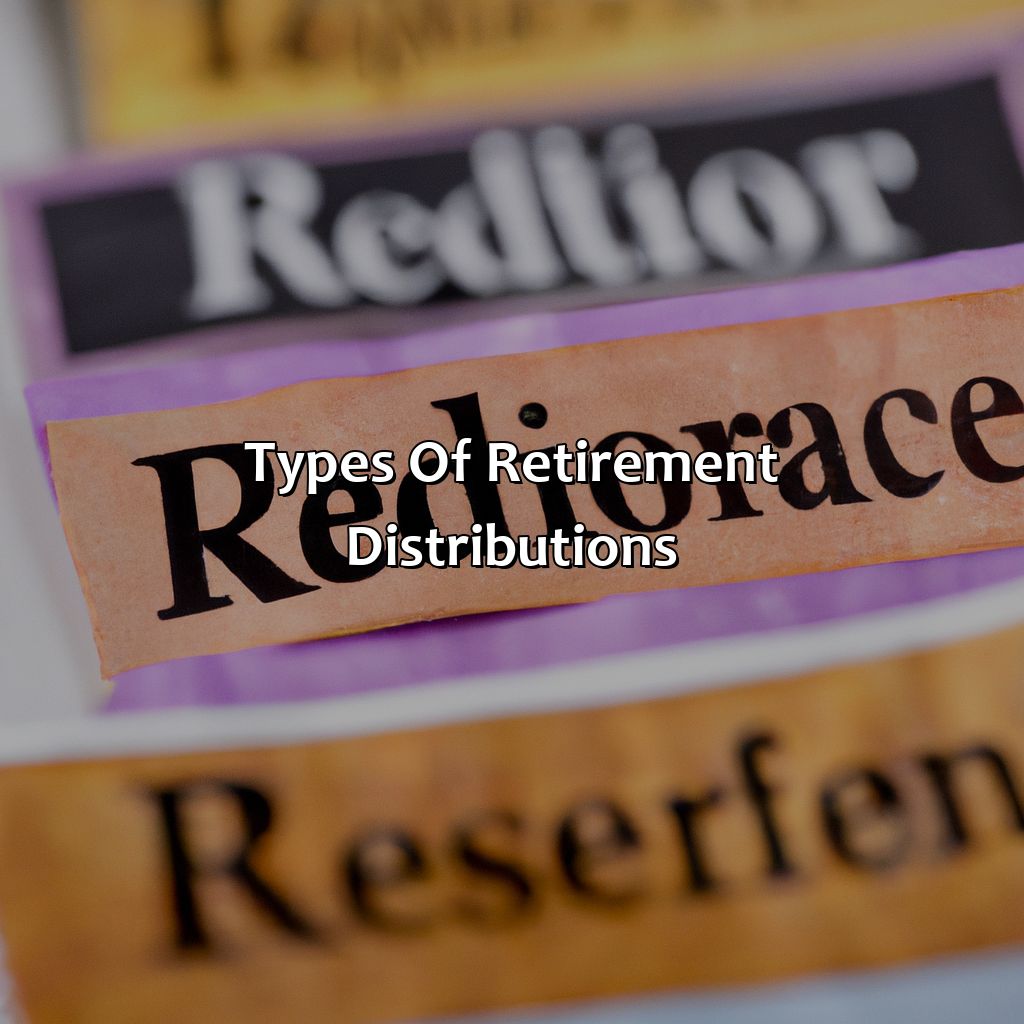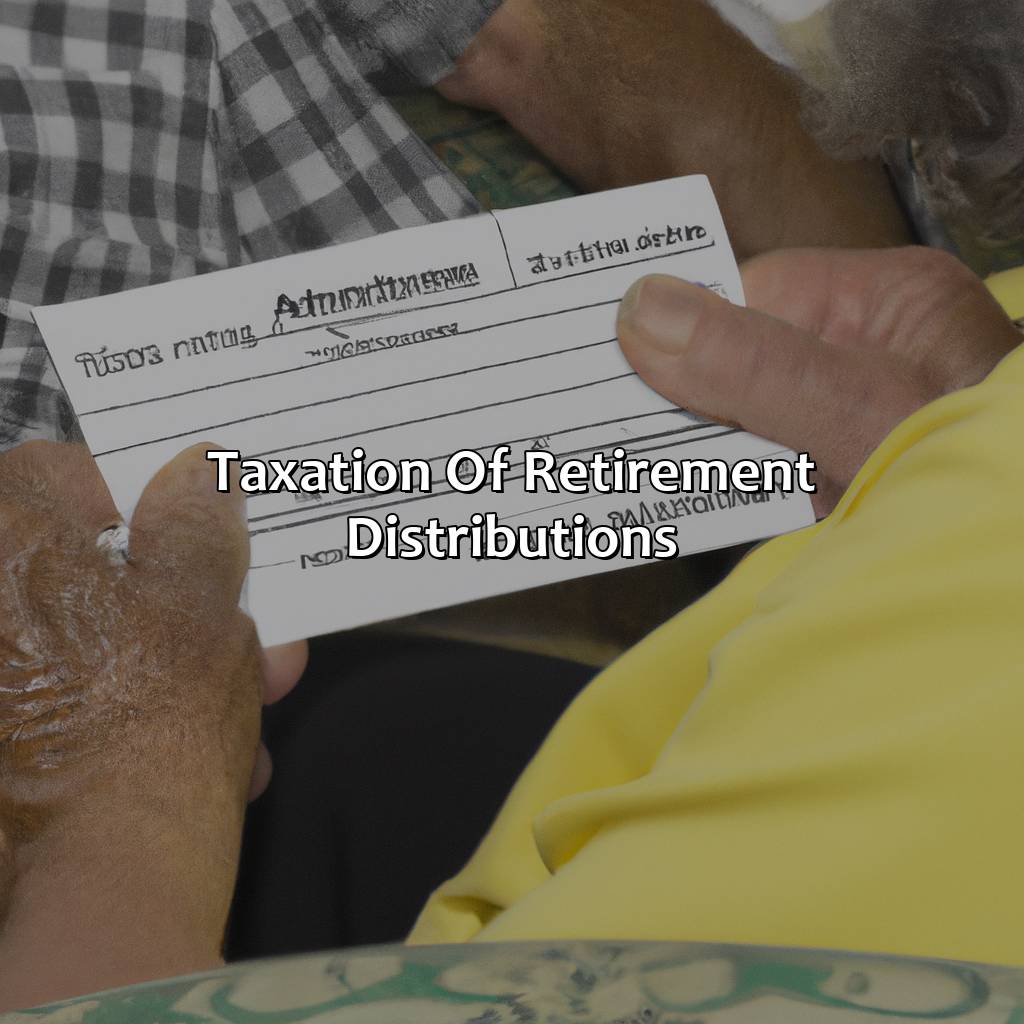What Are Retirement Distributions?
Key Takeaway:
- Retirement distributions refer to the withdrawal of funds from retirement accounts, such as 401(k)s and IRAs, to fund living expenses during retirement.
- There are three main types of retirement distributions: lump-sum distributions, periodic payments, and required minimum distributions (RMDs). The type of distribution depends on factors such as age, employment status, and retirement savings accounts.
- Retirement distributions are subject to taxation, with lump-sum distributions being taxed differently than periodic payments and RMDs. To maximize retirement distributions, individuals can delay social security benefits, consider Roth conversions, and strategically withdraw funds from their retirement accounts.
Are you concerned about planning for your retirement? Look no further! This article will provide you with all the information you need to understand retirement distributions. With this knowledge, you’ll be able to make informed and effective decisions when it comes to planning for your future.
Definition of Retirement Distributions
Retirement distributions refer to the funds withdrawn from a retirement account such as IRA, 401(k), or pension plan. These distributions are usually taxable and can be taken at a specific age or based on certain conditions. They help individuals manage their retirement income and ensure that they have enough funds for their post-retirement needs. It is crucial to understand the distribution rules and timing to avoid expensive tax penalties.
Retirement plans have strict rules and limitations on when and how much distributions can be taken based on the type of account and the age of the individual. One can take distributions in the form of a single lump sum payment, a series of distributions, or regular payments for their entire retirement period. The distribution amount and timing should be carefully planned to meet the individual’s financial requirements.
It is important to know the tax implications on retirement distributions before making any decisions. Taking distributions before the age of 59½ can result in a penalty of 10% and will be taxed according to the individual’s current income tax bracket. It is advisable to consult a financial planner or tax professional to understand the distribution rules and make informed decisions about retirement planning.
Neglecting the importance of proper retirement planning can lead to a severe shortage of funds in the post-retirement period, which can result in reduced living standards and stressful lifestyle changes. Start planning for your retirement distribution today, and secure a comfortable and worry-free future.
Image credits: retiregenz.com by Adam Duncun
Types of Retirement Distributions
Knowledge of various types of retirement distributions is key. Let’s explore three options: “Lump-Sum Distributions,” “Periodic Payments,” and “Required Minimum Distributions (RMDs).” Each has its own benefits. Welcome to “Types of Retirement Distributions!”

Image credits: retiregenz.com by Yuval Jones
Lump-Sum Distributions
Retirement Distributions are mandatory for individuals who have reached their retirement age. One type of distribution is receiving a large sum of money from their retirement accounts or pensions. These are commonly known as Lump-Sum Distributions.
With a Lump-Sum Distribution, the retiree receives all the money at once instead of getting paid monthly or annually. However, it is crucial to note that the amount received can be subject to high tax rates. Therefore, it is recommended to withdraw smaller amounts over an extended period instead of taking one large withdrawal.
It is important to educate oneself about different tax strategies and ways to minimize taxes on Lump-Sum Distributions, such as rolling over funds into a traditional IRA or contributing to a Roth IRA. To maximize the benefits of these distributions, one should analyze their financial situation before making any decisions and consider factors such as life expectancy, potential market risks, and other sources of income.
Overall, while Lump-Sum Distributions offer flexibility and convenience for retirees, proper planning and understanding tax implications are essential to make sound financial decisions regarding retirement savings plans.
Periodic payments – because who doesn’t love getting a little something every now and then, even in retirement?
Periodic Payments
Retirement payout in installments is known as ‘Periodic Distributions.’ They serve as a steady source of income for retirees over a specific term. These distributions are typically monthly but can also be quarterly or annually, according to the retiree’s preference.
Periodic payments are designed to meet the retirement needs of individuals while ensuring they do not run out of funds too early or too late. Additionally, making this decision involves careful considerations like expected returns, inflation rate and life expectancy. Once the amount is decided, it cannot be revised.
It’s worth mentioning that periodic payments may not provide enough money to cover sudden healthcare expenses or significant investments if they happen later on. For additional support, alternative investment options may be necessary to fulfill emergencies and ensure a comfortable standard of living.
According to Fidelity Investments, an individual may require up to 80% of their pre-retirement income per year to maintain their living standards during retirement.
“Why wait until you’re 70.5 to start taking money from your retirement account? Required Minimum Distributions – because the IRS likes to keep things interesting.”
Required Minimum Distributions (RMDs)
Retirement accounts require a specific distribution amount by law, known as the ‘minimum required withdrawal limit (MRWL)’. The amount is calculated based on the account holder’s age and account balance. It begins at 70½ for most individuals and must be withdrawn annually. The tax penalty for not achieving the MRWL is about half of what was expected to be withdrawn. Retirement account owners should communicate with their advisers or financial institutions to sort annual distributions from their investments efficiently.
One must keep in mind that MRWL typically applies to people who have retired and hold an IRA. If you’re still employed while holding such accounts, your employer-sponsored retirement plans may waive these requirements until you retire completely from employment or reach the age limit.
In summary, it is vital to plan withdrawals from retirement accounts thoroughly to avoid any potential tax implications. Individuals who fail to withdraw at least the minimum required amount face a severe tax penalty. Therefore, they should stay connected with their financial advisers to plan effectively for the future.
Retirement distributions depend on a lot of factors, but mostly on whether you chose to spend your savings on a yacht or on a lifetime supply of ramen noodles.
Factors Affecting Retirement Distributions
To get a better grip on how age, job status, and retirement savings accounts influence your retirement distributions, let’s take a closer look at each. Knowing the effects of age, work situation, and retirement savings accounts can help you maximize your retirement distributions.

Image credits: retiregenz.com by Joel Arnold
Age
One of the critical factors impacting retirement distributions is the chronological age of an individual. As an individual advances in years, their capacity to continue working for more extended periods decreases, and their health conditions may also deteriorate, leading to reduced earning capacity.
As a result of aging, older individuals are more likely to experience significant life changes such as health problems or loss of spouse. These factors impact their financial planning and investment strategies, and they may have to make adjustments in retirement plans accordingly.
It is essential to consider that age is not a fixed factor. Individuals who retire at the same time but differ in age will face different challenges when it comes to retirement distributions. The younger individual will have more opportunities to work longer and accumulate savings before they retire while the older individual will be forced to draw down on their retirement savings sooner.
John retired at 60 instead of his targeted age of 65 due to a job layoff. He had accumulated significant savings that he planned to rely on until he was eligible for Social Security benefits at 62. Unfortunately, two years into his early retirement, John was diagnosed with a serious health condition that required him to spend many healthcare expenses out-of-pocket sooner than expected. His early retirement and unexpected medical expensed significantly impacted his distribution plan with little room for maneuvering due to his age.
Retirement is like a break-up – it’s all about your employment status and how much money you’re willing to give up.
Employment Status
Individuals’ job position and work status can significantly impact their retirement distributions, which refer to the payments they receive from their retirement savings accounts. Retirement distributions can be affected by factors such as an individual’s retirement age, length of service with an employer, and employee compensation levels.
Retiring before the age of 59 ½ or leaving a job earlier than anticipated may result in early withdrawal penalties and tax implications. Additionally, those who work longer and receive higher salaries could potentially have more saved in their retirement accounts compared to those who worked for shorter amounts of time or earned lower wages.
It is crucial to consider employment status when planning for retirement as it can greatly impact an individual’s financial stability post-retirement. By ensuring they have a solid understanding of their employment status and accounting for related factors, individuals can better prepare themselves for financial security in their golden years.
Don’t miss out on securing your financial future by neglecting to take into account your employment status when planning for retirement. Consider speaking with a financial advisor to determine the best course of action for your unique situation. Your future self will thank you.
Retirement savings accounts are like plantains – they may seem unappetizing at first, but they’re actually quite versatile and perfect for any financial recipe.
Retirement Savings Accounts
Retirement accounts refer to financial products designed for individuals to save money for their retirement. Different account types offer different tax benefits and have varying contribution limits. Some of the most popular types include Individual Retirement Accounts (IRAs), 401(k) plans, and pension plans.
- IRAs allow individuals to contribute up to a certain amount each year, with contributions made on a pre-tax or after-tax basis.
- 401(k) plans are offered by employers where employees can contribute a portion of their salary into the account as pre-tax withholdings. The employer may also match some of the contributions made by the employee.
- Pension plans are offered by employers as part of an employee’s benefits package, guaranteeing payment to the retiree at set intervals.
- Other types of retirement accounts include annuities, Roth IRAs, and Simplified Employee Pension Plans (SEPs).
In addition to choosing which type of retirement account to use, individuals must also consider other factors such as investment strategy, fees, and withdrawal penalties when making decisions about their retirement savings.
Don’t delay in opening a retirement account or increasing contributions because every day counts towards achieving your retirement savings goals. By starting early and being consistent with contributions, you can enjoy a more comfortable lifestyle in your golden years.Retirement distributions may be taxed, but at least the government is giving you a parting gift before you kick the bucket.
Taxation of Retirement Distributions
Grasping the taxation of retirement distributions? This article drills into the various subsections. Knowing the taxation of lump-sum distributions, periodic payments, and RMDs is essential to optimize tax proficiency for retirement.

Image credits: retiregenz.com by Adam Jones
Taxation of Lump-Sum Distributions
Retirement distributions are subject to taxation, including lump-sum distributions. These refer to large sums of money that an individual withdraws from their retirement accounts at one time. Taxes on lump-sum distributions are calculated using a special tax formula based on how long the individual has had the retirement account, their age, and the amount of the distribution. This type of distribution may result in a significant tax burden for individuals.
It’s important to note that lump-sum distributions have different tax implications than other types of retirement account withdrawals, such as periodic payments or annuities. Additionally, there may be penalties for early withdrawals depending on the type of retirement account and the age of the individual.
Understanding the taxation of lump-sum distributions is crucial for individuals planning their retirement finances. Seeking guidance from a financial advisor or accountant can help to minimize taxes and avoid costly mistakes in managing retirement accounts.
Don’t miss out on maximizing your retirement savings! Properly managing your retirement accounts and understanding tax implications can lead to a more secure future. Consult with a financial professional today.
Whoever said ‘nothing is certain except death and taxes’ clearly forgot about the never-ending confusion of taxation of periodic payments.
Taxation of Periodic Payments
Retirement distributions are payments retirees receive from their retirement accounts. The Taxation of Periodic Payments is the process of calculating taxes on such distributions. Factors like age, type, and timing of contributions impact the tax treatment. The period over which the payments are made plays a crucial role in determining the taxation rate. In contrast, if the distribution is from a non-retirement account, then it will be taxed differently. Trusts and charitable donations also have unique taxation rules depending on various factors governing them.
RMDs – the government’s way of reminding you that even in retirement, you still owe them money.
Taxation of RMDs
Retirement distributions are taxed by the government as income. This includes the Required Minimum Distribution (RMD) that must be taken from certain retirement accounts once a person reaches 72 years old. The taxation of RMDs is based on the individual’s marginal tax bracket and the amount withdrawn. The higher the income, the higher the tax rate. It is important to plan for taxes on retirement distributions to avoid unexpected costs.
One way to potentially reduce taxes on RMDs is by implementing a Roth IRA. Unlike traditional IRAs where withdrawals are taxed, Roth IRAs offer tax-free distributions in retirement if certain requirements are met. Another option is to space out withdrawals over time, rather than taking one large lump sum, which can help keep an individual in a lower tax bracket.
It’s worth noting that if an individual fails to take their RMD, there can be significant penalties imposed by the IRS. In fact, failing to take an RMD results in a penalty of 50% of the required distribution amount.
According to Investopedia, “income taxes paid on traditional IRA and 401(k) contributions can be deducted on your federal income tax return” which can reduce your taxable income.
Maximizing retirement distributions is like playing a game of Tetris, try to fit all the pieces together and don’t leave any gaps!
Ways to Maximize Retirement Distributions
Maximizing retirement distributions? You can! Adopt these strategies: delay Social Security benefits, do Roth conversions, and make strategic withdrawals. Select the most efficient approach and you’ll get the most funds for your retirement years!
Delaying Social Security Benefits
Postponing Government Retirement Support
Waiting to claim social security benefits can increase retirement income significantly. By delaying the government retirement support, you’re allowing your investment to compound and offset inflation, leading to much higher payouts. Moreover, Delayed retirement credits (DRCs) can help. Once you reach full retirement age (FRA), delaying social security will earn you an additional 8% per year in DRCs until you turn 70. Try delaying benefits until age 70, as it increases social security payments by up to 32%.
Delaying Social Security Benefits leads to added flexibility for long-term financial planning. Opting for a later payout can relieve some financial stress during tough economic times. It allows seniors to maximize their lifetime earnings from social security, increasing their overall financial stability.
To ensure that this strategy works out best for your individual case and needs, taking time with carefully thought-out budget plans and analyzing various scenarios before deciding on the optimal claiming strategy is essential. An excellent option may be hiring a Certified Financial Planner CFP® professional focused on working with retirees or pre-retirees who specialize in forecasting returns based on investment selection, tax planning strategies, and withdrawal rates needed from different accounts for certain expenses.
Roth conversions are like the avocado toast of retirement planning, trendy but not for everyone.
Roth Conversions
Maximizing retirement distributions requires careful planning, including one strategy known as converting traditional IRAs to Roth accounts, also referred to as Roth Transformations. This tactic entails moving pre-tax funds from a traditional IRA into a post-tax Roth account. Taxes will need to be paid on the converted amount at the time of conversion. However, once transferred, funds in the Roth account can grow tax-free and do not require mandatory minimum distributions after age 72.
To maximize returns from this strategy, individuals should consider converting when their income is low or they experience significant losses from investments. Those already retired may want to convert gradually over a few years. However, it is essential to calculate carefully and remain within the confines of current tax brackets.
Furthermore, those with substantial future obligations for taxes on required minimum distributions (RMDs) may benefit from spreading out those payments more evenly before reaching age 72 by executing partial conversions each year. This action avoids RMD payment spikes that could push an individual into higher tax brackets.
Pro Tip: Careful and strategic planning can help maximize retirement distributions through effective use of Roth conversions and reduce potential tax obligations while preserving assets for future use.
Strategic Withdrawals
To optimize your retirement distributions, it is important to make strategic withdrawals from your accounts to ensure a sustainable income. By utilizing a literal meaning of “Strategic Withdrawals,” you can make well-considered decisions on when and how to withdraw your money, based on tax implications and other considerations specific to your financial situation. Effective planning can help preserve the longevity of your nest egg and mitigate potential financial risks in the long term.
By employing a diversified portfolio strategy and factoring in retirement goals and expenses, you can develop a plan that is tailored to your unique needs. This may involve adjusting the timing or amount of withdrawals from different accounts to minimize tax consequences or balance short-term needs with long-term sustainability. A knowledgeable financial advisor can provide valuable guidance in this regard.
It’s also important not to overlook the impact of required minimum distributions (RMDs) for certain types of accounts such as Traditional IRAs or 401(k)s after age 72. Failing to take RMDs could result in severe penalties, so it’s crucial that you stay informed about these regulations.
Research indicates that withdrawing an annual rate between 4% and 5% – adjusted for inflation – increases the chances of having enough savings throughout retirement. According to a study published by Morningstar, assuming a moderate asset allocation mix; this withdrawal rate offers higher probability of success during market volatility.
Five Facts About Retirement Distributions:
- ✅ Retirement distributions refer to the payments individuals receive from their retirement plans, such as 401(k) or IRA, when they reach retirement age. (Source: The Balance)
- ✅ There are different types of retirement distributions, including lump-sum and periodic payments, and different tax implications for each. (Source: Investopedia)
- ✅ The amount of retirement distributions a person receives depends on factors such as their contributions, investment returns, and life expectancy. (Source: Forbes)
- ✅ Retirement distributions can be a source of income in retirement but may also have implications for eligibility for government benefits such as Social Security. (Source: AARP)
- ✅ It is important to plan for retirement distributions and consider factors such as inflation, taxes, and healthcare costs when developing a retirement income strategy. (Source: Schwab)
FAQs about What Are Retirement Distributions?
What are retirement distributions?
Retirement distributions refer to the payments one receives from their retirement accounts, such as a 401(k) or IRA, when they reach retirement age. These payments are often necessary to supplement other sources of income during retirement.
When can I start receiving retirement distributions?
The age at which you can start receiving retirement distributions depends on the type of retirement account you have. For a traditional IRA or 401(k), you can start taking penalty-free distributions at age 59 1/2. For a Roth IRA, you can take tax-free distributions at any age if certain conditions are met.
How much can I withdraw from my retirement account each year?
The amount you can withdraw from your retirement account each year depends on a variety of factors, including your account balance, the type of retirement account you have, and your age. Additionally, there are IRS rules that dictate the minimum amount you must withdraw from certain types of retirement accounts each year.
What are the tax implications of retirement distributions?
Tax implications of retirement distributions vary depending on the type of retirement account you have. For example, traditional IRA and 401(k) distributions are generally taxed as ordinary income, while Roth IRA distributions are tax-free if certain conditions are met. It is important to consult a tax professional for specific advice regarding your retirement account.
Can I change the amount of my retirement distributions after I start receiving them?
Yes, you can typically change the amount of your retirement distributions after you start receiving them. However, there may be penalties or fees associated with changing the amount of your distributions, depending on the terms of your retirement account.
What happens to my retirement account when I pass away?
What happens to your retirement account when you pass away depends on a variety of factors, including your beneficiary designations and the specific rules of your retirement account. Generally, your retirement account will be passed on to your designated beneficiaries, who will be responsible for paying any taxes on the distributions they receive. It is important to keep your beneficiary designations up-to-date to ensure that your retirement account is distributed according to your wishes.





